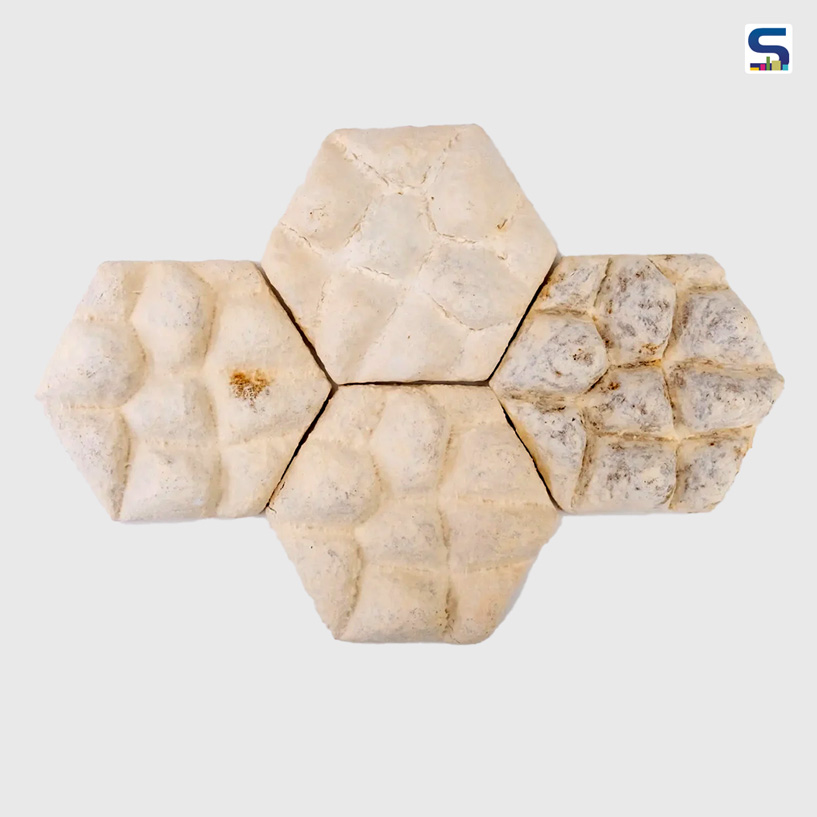
In a pioneering step towards sustainable building practices, a research team led by Nanyang Technological University (NTU), Singapore, has recently an innovative passive cooling solution in the form of fungi tiles. These unique wall tiles, composed of a mycelium-based composite material, the NTU researchers collaborated with local ecological design firm bioSEA to enhance the tiles’ cooling performance using bioinspired design. Know more about these revolutionizing tiles on SURFACES REPORTER (SR).
Nature-Inspired Cooling
The fungi tiles are crafted from a biodegradable biomaterial that combines the root-like fungal network known as mycelium with organic waste matter. This research reportedly builds on earlier findings which demonstrated that mycelium-bound composites possess superior insulation properties compared to conventional materials like expanded vermiculite and lightweight expanded clay aggregate.
Drawing inspiration from elephants that inhabit hot, often humid, tropical climates and regulate their body temperature through the wrinkles in their skin, the team designed the surface of the mycelium tiles to mimic this heat-regulating texture. Since elephants lack sweat glands, their skin’s folds and cracks help retain water and facilitate evaporative cooling. Explaining the inspiration behind the innovation, Dr Anuj Jain, Founding Director, bioSEA, he said, “Elephants are large animals that live in hot and sometimes humid tropical climates. To withstand the heat, elephants evolved to develop a skin that is heavily wrinkled which increases water retention and cools the animal by evaporation. We were inspired by how an elephant could cool itself in hot weather without sweat glands, and tried to see how we could replicate the same cooling mechanisms of shading, trapping cool air, and increasing the surface area for water to evaporate.” Using computational modelling and algorithms, bioSEA developed a pattern that maximized surface area while supporting water retention, thereby enhancing thermal regulation.
According to the published research paper ‘Biodegradable mycelium tiles with elephant skin inspired texture for thermal regulation of buildings’ published in Energy and Buildings in Volume 328, 1 February 2025, laboratory testing revealed promising results. When compared to flat mycelium tiles, the elephant-skin-inspired tiles demonstrated a 25 per cent improvement in cooling performance and a 2 per cent reduction in heat absorption rate. In simulated rain conditions, the cooling efficiency of the textured tiles increased by an impressive 70 per cent, showcasing their potential for deployment in tropical regions where humidity and rainfall are prevalent.
Revolutionizing Green Construction
The production process of these tiles is equally eco-conscious. For this study, researchers used Pleurotus ostreatus, commonly known as oyster mushrooms, grown on a substrate of bamboo shavings mainly sourced from a furniture shop, oats and water. The mixture was packed into a custom-designed hexagonal mould with the elephant-skin texture and left to grow in the dark for two weeks. After the initial growth, the tiles were unmoulded and left to mature under the same conditions for another two weeks. In the final stage, they were oven-dried at 48°C for three days to halt any further fungal activity and prepare the tiles for use.
To evaluate their thermal performance, the tiles were exposed to a 100°C hot plate for 15 minutes, and changes in surface temperature were monitored using an infrared camera. When the textured surface faced the heat source, the tile’s temperature rose at a slower rate from 5.01°C per minute compared to 5.85°C per minute for the flat side.
Cooling performance was also measured by heating the tiles and then allowing them to cool in ambient conditions. The tile cooled most efficiently when its flat side had been heated and its textured side was exposed to the environment, showing a cooling rate of 4.26°C per minute. The textured-heated side cooled at 3.12°C per minute, while the flat control tile cooled at 3.56°C per minute.
To mimic rain, researchers sprayed water on the tiles every minute for 15 minutes while monitoring their cooling rate. The textured tile, when misted on its bumpy side, demonstrated an accelerated cooling rate of 7.27°C per minute, which was about 70 per cent higher than its dry counterpart. This is attributed to the hydrophobic surface layer developed during fungal growth, which helps retain water droplets on the surface longer, boosting evaporative cooling.
Roadmap Ahead
While these early results are promising, challenges remain in transitioning the tiles from lab to real-world applications. The team is reportedly now working with local start-up Mykilio to enhance tile durability, explore alternative fungal strains and scale up for outdoor façade testing. One limitation is the time-intensive production process that requires three to four weeks of growth, though it uses minimal energy. Another hurdle is overcoming the industry’s disinterest, given the dominance of synthetic insulation materials backed by well-established supply chains.
According to Associate Professor Hortense Le Ferrand, who led the study and holds joint appointments at NTU’s Schools of Mechanical and Aerospace Engineering and Materials Science and Engineering, “Insulation materials are increasingly integrated into building walls to enhance energy efficiency, but these are mostly synthetic and come with environmental consequences throughout their life cycle. Mycelium-bound composite is a biodegradable material that is highly porous, which makes it a good insulator. In fact, its thermal conductivity is comparable to or better than some of the synthetic insulating materials used in buildings today.”
Image credit: Nanyang Technological University, Singapore and bioSEA